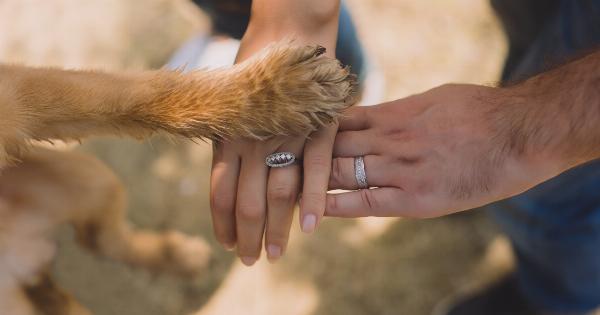Dogs have been domesticated for thousands of years, but they still retain many of their primal instincts from their wild ancestors. These instincts can influence their behavior, communication, and overall well-being.
As dog owners, it is essential to understand these primal instincts to provide proper care and training to our furry companions. In this article, we will delve into the fascinating world of a dog’s primal instincts and explore how they impact their lives.
The Pack Mentality: Dogs as Social Animals
One of the most prominent primal instincts in dogs is their innate pack mentality. Dogs are social animals that have evolved to live and work together in groups.
In the wild, packs are essential for survival, as they provide protection, resources, and support for each other. This pack mentality still influences domesticated dogs today, as they often view their human family as their pack.
This pack mentality manifests in various ways, such as a dog’s need for social interaction and hierarchy within the pack.
Dogs thrive in environments where they feel part of a pack, which is why they often display separation anxiety when left alone for extended periods. It’s crucial for dog owners to provide the socialization and companionship that mimic a pack setting to keep their dogs emotionally and mentally balanced.
The Hunting Instinct: Prey Drive
Another primal instinct that dogs have retained from their wild ancestors is their hunting instinct or prey drive. Wild dogs needed to hunt for survival, and this instinct has been deeply ingrained in their DNA.
While domesticated dogs may not rely on hunting for sustenance, their prey drive still influences their behavior.
A dog’s prey drive can manifest in their chase instincts, inclination to pounce on smaller animals or objects, and an intense focus on moving targets.
For some dogs, this instinct can be challenging to control, especially in high-stress or stimulating situations. Understanding and appropriately channeling this prey drive through training and providing alternative outlets can help prevent destructive behavior and ensure the dog’s well-being.
Guarding and Territorial Instincts: Protecting Their Territory
Dogs are natural guardians, and their territorial instincts stem from their wild ancestors’ need to protect their hunting grounds and dens.
Even though the concept of territory may have shifted in a domestic environment, dogs still exhibit guarding behavior over their living space, toys, and sometimes even their owners.
A dog’s territorial instincts can range from mild alertness to aggressive behavior, depending on the individual and their upbringing.
Proper training and socialization play a crucial role in ensuring that these instincts do not escalate into problematic behavior. Understanding a dog’s territorial instincts can also help owners create a safe and secure environment for their pets.
Communication through Body Language
Dogs primarily communicate through body language, and understanding their non-verbal cues is essential for effective interactions. Many of these body language signals have roots in a dog’s wild heritage and serve as means of survival in the wild.
By observing a dog’s body language, we can gain insights into their emotional state and intentions.
Some common body language signals that stem from a dog’s wild instincts include:.
-
1. Tail wagging:
A wagging tail can express a range of emotions, from excitement to anxiety. It is crucial to consider the overall body posture and other cues to interpret the meaning accurately.
-
2. Raised hackles:
When a dog’s fur along the back and shoulders stands on end, known as raised hackles, it signifies arousal or aggression.
-
3. Lip licking:
Lip licking is often a sign of stress or anxiety in dogs. It can signal discomfort and a desire to diffuse a potentially tense situation.
-
4. Play bow:
When a dog lowers their front end into a bowing position with their rear end up, it is a gesture inviting play. This behavior originates from a wild dog’s hunting posture.
-
5. Direct eye contact:
In the wild, direct eye contact often serves as a challenge or threat. Some dogs may perceive prolonged eye contact as confrontational or intimidating.
Understanding these body language signals can enhance communication and help prevent misunderstandings or conflicts between dogs and humans, as well as between dogs themselves.
Scent Marking: Leaving Their Signature
Dogs, like their wild counterparts, use scent marking as a way to communicate. By leaving their scent on objects or marking specific areas, dogs convey information to other animals, such as their presence, territorial boundaries, or reproductive status.
This primal instinct is deeply ingrained in dogs and is often demonstrated through urine marking or rubbing against objects.
Many dogs feel the need to mark their territory, both indoors and outdoors. Neutering or spaying can help reduce this behavior in some dogs, but it is essential to understand that scent marking serves a fundamental purpose for dogs.
Providing appropriate outlets, such as designated marking areas, can help manage this instinctual behavior without suppressing it entirely.
Pack Hierarchy: The Alpha and Dominance Theory
The concept of pack hierarchy is another behavioral aspect influenced by a dog’s primal instincts. In the wild, packs have a clear hierarchical structure with an alpha leader at the top.
Some trainers and dog behaviorists believe that establishing dominance and asserting oneself as the alpha leader is crucial in training and managing dogs.
However, it is important to note that the dominance theory has increasingly been debunked in recent years.
Many canine behavior experts now advocate for positive reinforcement-based training techniques that focus on building a strong bond and mutual trust rather than using dominance-based methods. Understanding a dog’s pack mentality and their need for guidance and structure can help shape training approaches that are effective and humane.
The Role of Play: Tapping into Natural Instincts
Play is an essential aspect of a dog’s life and helps fulfill many of their natural instincts. Play mimics elements of a dog’s predatory behavior, such as chasing, pouncing, and wrestling.
It also serves as a means for social bonding and learning important skills.
Providing opportunities for structured and interactive play can help channel a dog’s energy, prevent boredom, and strengthen the bond between dog and owner.
Engaging in activities like fetch, tug-of-war, or puzzle toys allows dogs to tap into their primal instincts while having fun.
Instinct vs. Domestication: Striking a Balance
While dogs retain many primal instincts from their wild ancestors, it is crucial to strike a balance between honoring their instincts and adapting to domesticated life.
Understanding these instincts can guide us in providing appropriate outlets, socialization, and training methods that address their natural needs.
Remember to consult professional trainers or behaviorists if you encounter persistent behavioral issues or need expert guidance in understanding and working with your dog’s primal instincts.
With the right knowledge and approach, we can ensure that our four-legged friends thrive in our human world while staying connected to their wild roots.






























